ELECTIONS USA
>
Christellecarlier
>
LYCEE
>
IDENTITE ET ECHANGES
Why Can't Third Parties Take Off?
US Presidential Election explained (explainity® explainer video)
How Does The President Get Elected? US Presidential Elections Explained. Coronavirus Stimulus Bill, Schools and the Democratic National Convention: The Week in Cartoons for Aug. 17-21. 2020 Presidential Election Interactive Map - Electoral Vote Map. Identifying the 2020 Battleground States - Electoral Vote Map. When we forecast the 2020 electoral map based on the 2018 midterm election results, it becomes very clear that President Trump must wage a two-front war to win re-election in a new set of 2020 battleground states: He must defend the Rust Belt states that sealed his victory in 2016, also defend against clear Republican erosion in the Sunbelt.
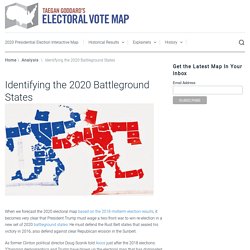
As former Clinton political director Doug Sosnik told Axios just after the 2018 elections: “Changing demographics and Trump have blown up the electoral map that has dominated American politics since 1992.” Looking Ahead to the 2020 Election Sosnik projects that there could be more tossup states in the South and Southwest than in the Midwest — with almost twice the number of electoral votes at stake. He notes that the midterm elections also showed “that without Hillary atop the ticket, Midwest states like Wisconsin are tough for Trump, and Southern states with rising Hispanic populations are slowly growing more Democratic.”
100 days: America in a time of Trump. Image copyright Chris Kindred Presidential elections are always something of a national Rorschach test.
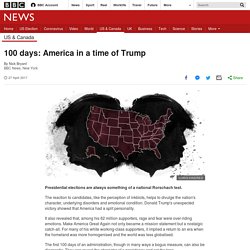
The reaction to candidates, like the perception of inkblots, helps to divulge the nation's character, underlying disorders and emotional condition. Donald Trump's unexpected victory showed that America had a split personality. It also revealed that, among his 62 million supporters, rage and fear were over-riding emotions. Make America Great Again not only became a mission statement but a nostalgic catch-all. The first 100 days of an administration, though in many ways a bogus measure, can also be diagnostic. Also they are indicative of the health of US democracy: the functioning of its institutions, executive, legislative and judicial; the workability of the US constitution and the dispersion of political, economic and cultural power.
Dates to Watch in 2020 Election.
Inventing the American presidency - Kenneth C. Davis.
Retenus
POLITICAL SYMBOLS AND COLOURS. Why Two Parties Dominate American Politics. What Do Republicans Believe?
Why Can't Third Parties Take Off?
How Did The U.S. End Up With A Two-Party System?
What Are The Differences Between The Republican And Democratic Parties: sciBRIGHT Politics. Who Can Run For President?
What Do Democrats Believe?
Can A Third-Party Candidate Ever Become President?
The Daily Show - Making Sense of the Electoral College. The Electoral College: Why Such A Big Debate?
The Popular Vote vs. the Electoral College. Inside the Night McCain Helped Doom the Republican Health Care Bill.
Liberals vs Conservatives - Which Brain is Better?
The oddities of the first American election - Kenneth C. Davis. The History of U.S. Presidential Elections. The electoral college. Why the Electoral College?
Why The Electoral College Exists. The Trouble with the Electoral College. How The Electoral College Works. Election Night - SNL. How the Electoral College Works in 6 Minutes. The weird rule that broke American politics. Do You Understand the Electoral College?
How the Electoral College Works. Road to the White House 2020. Election Printables, Lessons, & Activities (K-12)
DOCUMENTS RETENUS
IDEES TACHES. PROCESSUS ELECTORAL. PROFILS CANDIDATS 2020. Election 2016: Lesson Plans and Digital Resources for Educators. This election has been unlike any in modern history.
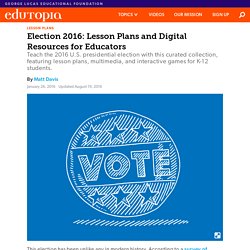
According to a survey of educators by Teaching Tolerance, the campaign’s contentious tone has spilled over into classrooms. Presidential elections are exciting for students and provide an opportunity to discuss and debate a range of issues in the classroom. But this year, that excitement is more likely to turn into conflict. Setting ground rules and promoting civility in debates can help students avoid conflicts and encourage fruitful debates.
How?
Election Lesson Plans & Resources: Democracy in Action. The Electoral Process. iCivics. Election Day is held on the Tuesday after the first Monday in November.
Grades 3 – 5 | Lesson Plan | Unit Voting!
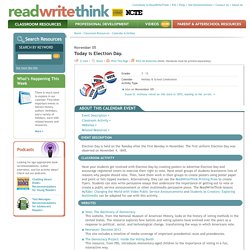
What's It All About? Students explore a variety of sources for information about voting. They evaluate the information to determine if it is fact or opinion, and then create a graffiti wall about voting. Grades 4 – 5 | Lesson Plan | Standard Lesson. American Party Animals. Pbslearningmedia. Pbslearningmedia. Election Day is held on the Tuesday after the first Monday in November.
Presidential Election Lesson Plans and Lesson Ideas. Election Printables, Lessons, & Activities (K-12)
Electing a US President in Plain English. Concern grows over postal service as Trump continues attack on mail-in voting. How to Become President of the United States.
Comment parler des élections américaines en classe ?
Après les conventions républicaine et démocrate, c'est maintenant la période des clips et des news, jusqu'au vote le 6 novembre.
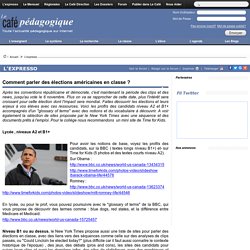
Plus on va se rapprocher de cette date, plus l'intérêt sera croissant pour cette élection dont l'impact sera mondial. Faites découvrir les élections et leurs enjeux à vos élèves avec ces ressources. Voici les profils des candidats niveau A2 et B1+ accompagnés d'un "glossary of terms" avec des notions et du vocabulaire à découvrir. A voir également la sélection de sites proposée par le New York Times avec une séquence et des documents prêts à l'emploi. Pour le collège nous recommandons un mini site de Time for Kids. Lycée , niveaux A2 et B1+ Pour avoir les notions de base, voyez les profils des candidats, sur la BBC ( textes longs niveau B1+) et- sur Time for Kids (5 photos et des textes courts niveau A2). Sur Obama : Romney : et deux fiches prêtes à l'emploi, une pour analyser les articles de presse et une pour les clips vidéos: En collège Christine Reymond.
Joe Biden delays vice president pick, undergoing extensive review of potentials.





